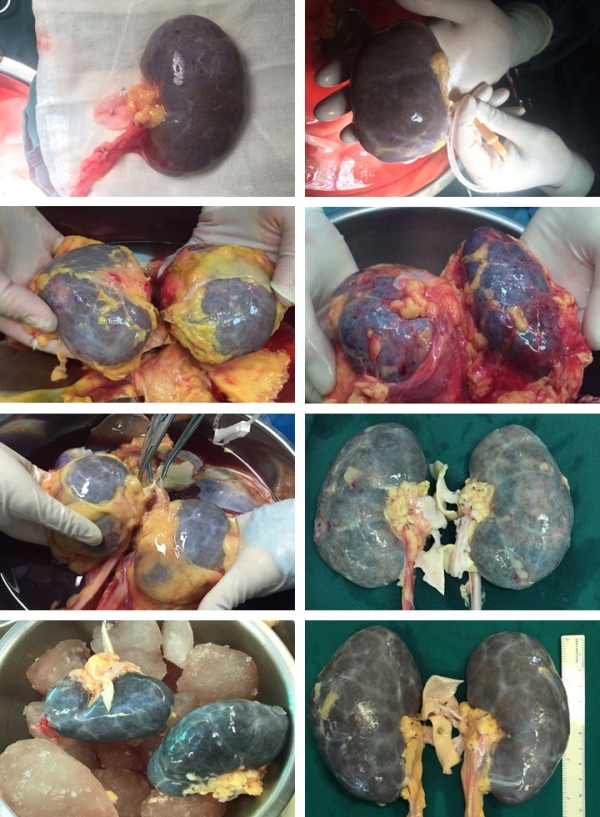Successful Transplantation of Black Kidneys from Rhabdomyolysis Donors
1Organ Transplant Center, First Affiliated Hospital of Sun Yat-sen University, Guangzhou, China
2Department of Urology, First Affiliated Hospital of Guangxi University of Chinese Medicine, Nanning, China
3Department of Urology, Chinese PLA General Hospital, Beijing, China.
Meeting: 2018 American Transplant Congress
Abstract number: C40
Keywords: Donors, Kidney transplantation, Machine preservation, marginal
Session Information
Session Name: Poster Session C: Kidney Donor Selection / Management Issues
Session Type: Poster Session
Date: Monday, June 4, 2018
Session Time: 6:00pm-7:00pm
 Presentation Time: 6:00pm-7:00pm
Presentation Time: 6:00pm-7:00pm
Location: Hall 4EF
Background: The kidneys from donors with rhabdomyolysis and acute kidney injury (AKI) may show discolored appearance. The transplant surgeons may be unwilling to accept a kidney with AKI and black appearance, especially when the kidney is anuric.
Method: Fourteen discolored kidneys from 7 deceased donors with severe rhabdomyolysis and AKI were accepted for transplantation at our centers.  Generally, we accept kidneys with a resistance < 0.4 mmHg/mL/min in pump perfusion when an preimplant biopsy excludes cortical necrosis and chronic lesions (> 10% glomerulosclerosis, interstitial fibrosis, tubular atrophy). The kidney transplant results of 14 black kidneys from rhabdomyolysis donors were compared with those of 30 renal grafts from standard criteria donors (SCD).
Generally, we accept kidneys with a resistance < 0.4 mmHg/mL/min in pump perfusion when an preimplant biopsy excludes cortical necrosis and chronic lesions (> 10% glomerulosclerosis, interstitial fibrosis, tubular atrophy). The kidney transplant results of 14 black kidneys from rhabdomyolysis donors were compared with those of 30 renal grafts from standard criteria donors (SCD).
Results: Two donors received continuous renal replacement therapy due to anuria. The peak serum creatinine kinase (CPK), myoglobin, and serum creatinine of the these donors was 27738 ± 7394 U/L, 76003 ± 50708 [mu]g/L, and 442 ± 214 [mu]mol/L, respectively. Pathological examination showed luminal myoglobin casts or tubular epithelial cell reaction for myoglobin in the absence of luminal casts.  The eGFR at 1 years post-transplantation was similar between black kidneys from donors with rhabdomyolysis and SCD (69.8 ± 13.6 ml/min/1.73m2 vs. 71.2 ± 15.1 ml/min/1.73m2, P = 0.56).
The eGFR at 1 years post-transplantation was similar between black kidneys from donors with rhabdomyolysis and SCD (69.8 ± 13.6 ml/min/1.73m2 vs. 71.2 ± 15.1 ml/min/1.73m2, P = 0.56).
Conclusion: If the rhabdomyolysis donor has a peak serum CPK > 20 000 U/L and has tea-colored urine, the kidneys are likely to have a black appearance. Discolored kidneys from rhabdomyolysis donors with AKI can achieve excellent graft function, even when the kidneys are anuric.
CITATION INFORMATION: Yuan X-.P., CHen C-.B., Zheng Y., Gu X., Zu Q., Wang C., He X. Successful Transplantation of Black Kidneys from Rhabdomyolysis Donors Am J Transplant. 2017;17 (suppl 3).
To cite this abstract in AMA style:
Yuan X-P, CHen C-B, Zheng Y, Gu X, Zu Q, Wang C, He X. Successful Transplantation of Black Kidneys from Rhabdomyolysis Donors [abstract]. https://atcmeetingabstracts.com/abstract/successful-transplantation-of-black-kidneys-from-rhabdomyolysis-donors/. Accessed December 26, 2025.« Back to 2018 American Transplant Congress
